Proceedings: The Titanic Disaster
📌 This in-depth 1962 naval account of the Titanic disaster by John C. Carrothers explores the tragedy through engineering analysis, wireless operations, and command decisions. A must-read for teachers, students, historians, and maritime scholars.
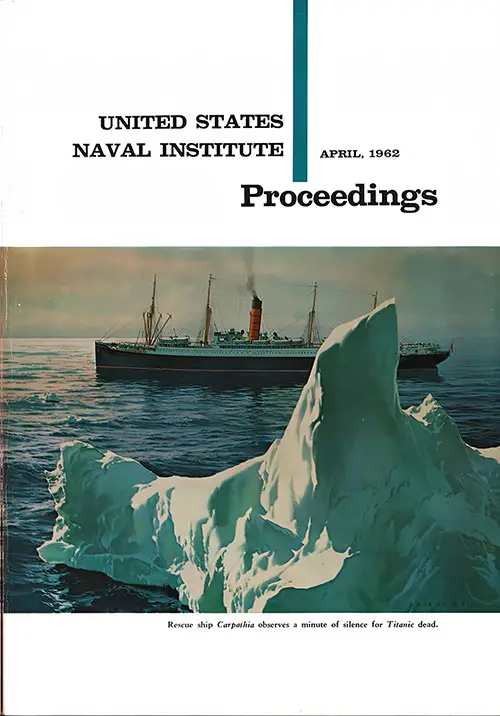
Front Cover, United States Naval Institute Proceedings. Featured Image: Rescue Ship Carpathia Observes a Minute of Silence for Titanic Dead. (Proceedings, April 1962) | GGA Image ID # 226baea851
Fifty years ago this month, a great new ship was rushing westward through the night at 23 knots. Suddenly, a lookout cried, "Iceberg dead ahead. Sir!" Ironically, had the watch been less alert, the Titanic might not have sunk.
by John Carroll Carrothers
🚢 Review & Summary: The Titanic Disaster - A Naval Chronicle of Tragedy and Heroism
John Carroll Carrothers' compelling retrospective in the April 1962 issue of United States Naval Institute Proceedings offers a detailed, reverent, and technically grounded recounting of the sinking of the RMS Titanic, published 50 years after the disaster. This deeply researched naval account goes beyond the basic story most readers know, making it an exceptional resource for classroom use, maritime history, and personal research.
📌 Why it matters: This article is not a dramatized retelling, but a serious examination of procedural decisions, engineering failures, wireless communications, ship handling, and the moral aftermath—all examined through the lens of mid-century naval and engineering expertise.
🎓 Educational & Historical Relevance
Teachers, students, historians, and genealogists will find this article essential for studying:
📡 The role of wireless operators in maritime rescue history (Phillips & Cottam)
⚙️ Engineering and nautical design decisions that led to failure
🛳️ Rescue logistics and leadership under duress (Captain Rostron & the Carpathia)
❄️ Ice navigation protocols and the fatal misjudgment of risk
🚨 The Californian controversy and the ethics of maritime response
📜 Policy outcomes: laws requiring lifeboats for all, 24-hour radio watches, ice patrols
🧳 Relevance to Ocean Travel History & Genealogy
This article offers authentic maritime context for genealogists researching Titanic passengers and crew. With references to:
- Ship classes and layouts
- Onboard hierarchies
- Wireless technology
- Rescue timelines
- Maritime laws
…it's ideal for building historical context around family stories, letters, or travel records tied to the Titanic or other early 20th-century ocean liners.
🌟 Most Engaging Highlights from the Article
🚨 1. The Missed Warnings
The Titanic received multiple iceberg warnings, including one from the Mesaba that reported ice directly in its path. These messages—some unread, some ignored—form one of the most sobering elements of this retelling.
🚢 2. The Role of the Californian
A chilling section recounts how the S.S. Californian saw the Titanic’s distress rockets but failed to act decisively. The article carefully outlines the timeline of observation, misinterpretation, and ultimately missed opportunity.
📡 3. Wireless Heroism & Failure
We witness Jack Phillips of the Titanic, who died at his post, and Harold Cottam of the Carpathia, who answered the call. These Marconi operators symbolize both the tragedy and triumph of early 20th-century radio communication.
🌊 4. Carpathia’s Midnight Rescue
One of the most moving sequences describes how Captain Arthur Rostron and his crew pushed the Carpathia to its limits—plunging through iceberg-laden seas at unprecedented speed—to save 712 lives. The tension and detail rival that of any cinematic drama. 🎬
📸 Noteworthy Images That Bring History to Life
🖼️ Rescue Ship Carpathia Observes a Minute of Silence
🕯️ Front cover image—a solemn, haunting tribute at sea that sets the tone for the article’s reverence.
🖼️ Thousands Gather in New York for Titanic Bulletins
📢 Vividly shows the global impact of the disaster and the birth of modern breaking news coverage.
🖼️ Titanic’s Majestic Scale vs. Its Tragic Fate
🚢 An image of the Titanic's size and grandeur—underscoring how even the most advanced engineering was vulnerable to nature and hubris.
🖼️ Jack Phillips & Harold Cottam
📡 Highlights the heroism of wireless operators, a crucial focus for students studying communication history and emergency protocol.
🖼️ Lifeboat Rescue Image + Arrival of Survivors
⛵ Contrasts life-saving effort with trauma and survival—important for discussions of mental health and disaster resilience.
🖼️ The Titanic’s Lavish Amenities
🎻 The Turkish bath and orchestra represent how luxury was prioritized over safety—a discussion point for students of ethics in design and transportation.
🧭 A Tool for Teaching Ethics, Engineering & Memory
Teachers across disciplines—history, literature, STEM, journalism, civics—can use this article to:
- Explore how one decision (canceling the lifeboat drill) can alter history
- Examine the role of leadership in disaster scenarios
- Compare media vs. reality in maritime disaster coverage
- Encourage critical analysis of primary sources
📚 Essay prompt idea for students:
“How did the decisions made by the Titanic’s crew—and those of nearby ships—shape both the outcome and the legacy of the disaster? Use GG Archives sources to support your answer.”
✍️ Student Essay Tip
Although this article originally appeared in a print issue of Proceedings, many students may find it in local libraries or online archives. Use this article alongside GG Archives’ Titanic materials—like passenger lists, ship documents, and survivor reports—to write an essay that blends technical, emotional, and historical analysis. 💡📖
🧠 Why This Article Still Matters
🛳️ Titanic wasn’t just a ship—it was a symbol of modern hubris, a floating palace where luxury overtook safety, and a moment that changed the laws of the sea forever. This article reminds us that the story isn’t just about ice and iron, but about people, decisions, and the consequences of inaction.
From an educational standpoint, this 1962 article stands out for:
📘 Meticulous chronology
🔎 Balanced engineering and emotional narrative
🧭 Post-disaster policy insight
🗣️ Final Thoughts
This article reminds us that technology alone does not ensure safety—and that empathy, vigilance, and preparedness are the real lifeboats in any voyage.
🔥 For educators, researchers, or curious minds, this is more than a historical article—it's a mirror reflecting the consequences of human error, ethical choices, and the unrelenting power of nature.
Article Image Gallery
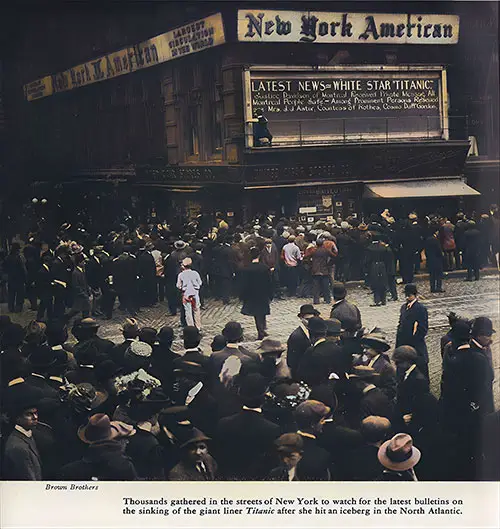
Thousands Gathered in the Streets of New York to Watch the Latest Bulletins About the Sinking of the Giant Liner Titanic After It Struck an Iceberg in the North Atlantic. Photo by Brown Brothers. (Proceedings, April 1962) | GGA Image ID # 2269bd6a26

The Titanic Was One of the Greatest Liners Ever Built. She Measured 883 Feet in Length, Had a Cruising Speed of 23 Knots, and Could Accommodate Approximately 3,000 Passengers and Crew Members. Built-in 1912, It Cost Nearly Ten Million Dollars to Construct. Photo by Brown Brothers. (Proceedings, April 1962) | GGA Image ID # 2269cced67

Although Publicized as “Unsinkable,” the Titanic Went Down in Less Than Three Hours After Striking the Iceberg. Lost With the Great Ship Were 1,503 Persons of the 2,215 on Board. Brown Brothers From a Painting by Willy G. Tower. Photo by Brown Brothers. (Proceedings, April 1962) | GGA Image ID # 226a031757

Marconi Operator Jack C. Phillips of the Titanic Stayed at His Wireless Set Until the Ship Sank. Photo by Brown Brothers. (Proceedings, April 1962) | GGA Image ID # 226a0d227f
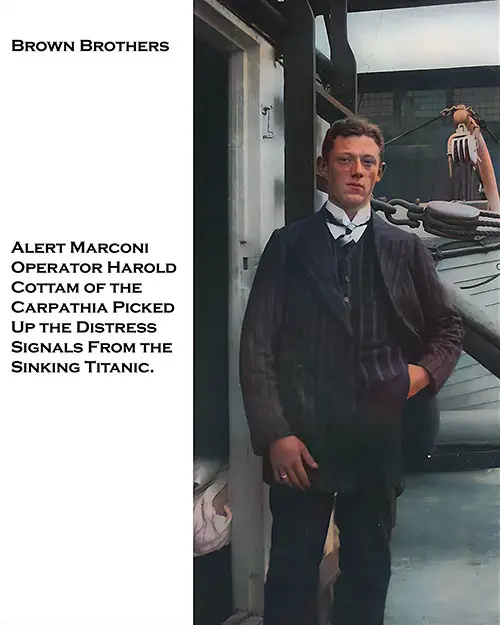
Alert Marconi Operator Harold Cottam of the Carpathia Picked Up the Distress Signals From the Sinking Titanic. Photo by Brown Brothers. (Proceedings, April 1962) | GGA Image ID # 226a2b03fc
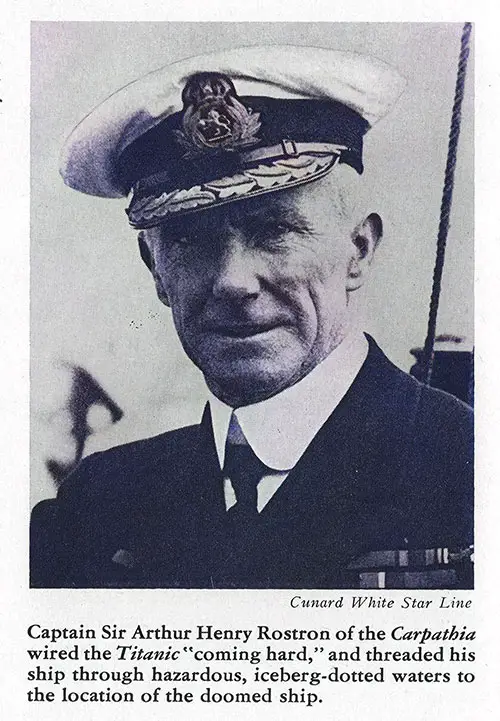
Captain Sir Arthur Henry Rostron of the Carpathia Wired the Titanic “Coming Hard” and Threaded His Ship Through Hazardous, Iceberg-Dotted Waters to the Location of the Doomed Ship. Photo Courtesy of Cunard White Star Line. (Proceedings, April 1962) | GGA Image ID # 226a36f8cb
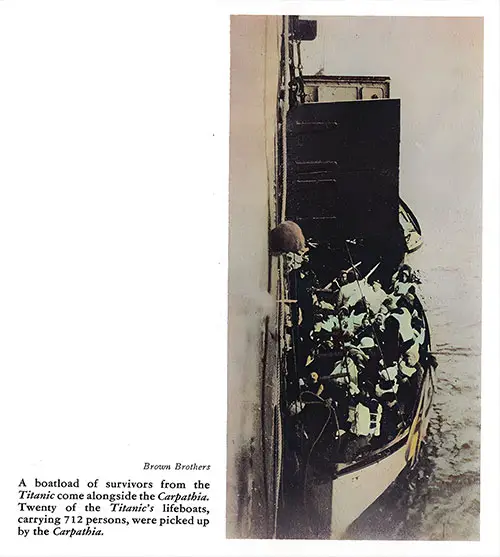
A Boatload of Survivors From the Titanic Came Alongside the Carpathia. the Carpathia Picked Up Twenty of the Titanic’s Lifeboats, Carrying 712 Persons. Photo by Brown Brothers. (Proceedings, April 1962) | GGA Image ID # 226b0ee9be
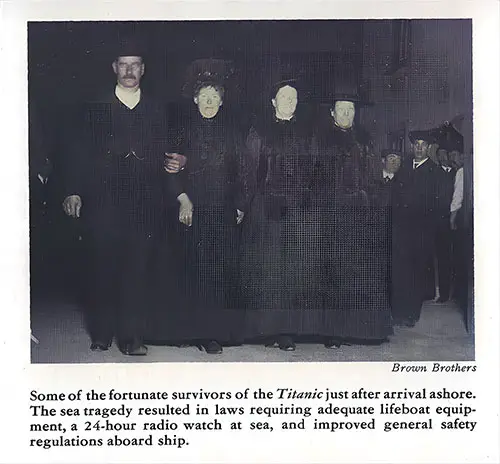
Some of the Fortunate Survivors of the Titanic Just After Arrival Ashore. the Sea Tragedy Resulted in Laws Requiring Adequate Lifeboat Equipment, a 24-Hour Radio Watch at Sea, and Improved General Safety Regulations Aboard Ships. Photo by Brown Brothers. (Proceedings, April 1962) | GGA Image ID # 226b5c95ed

The Titanic Represented the Pinnacle of Luxury, Featuring a Turkish Bath and an Orchestra Playing Every Night in the Elegant Main Ballroom. Photo by Brown Brothers. Photo by Brown Brothers. (Proceedings, April 1962) | GGA Image ID # 226b6e139a

About the Author: John Carroll Carrothers Was a Surveyor in the Construction and Repair Division of the Matson Navigation Company, San Francisco, During World War II. He Has Sailed as a Chief Engineer With the Matson Company and as a Watch Engineer With the United States Lines. Carrothers Has Also Been an Inspection Engineer With the Vitro Corporation of America, Builders of the Atomic Energy Plant at Hanford, Washington. He Is the Chief Engineer at Overlook Hospital, Summit, NJ. (Proceedings, April 1962) | GGA Image ID # 226bc23061
